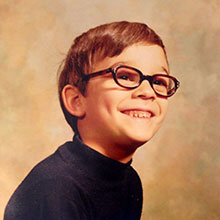A souvenir of my first trip to Germany has held pride of place on my writing desk since I returned from a couple weeks there this past spring. It’s a simple postcard, bright yellow stock with black all-cap text that reads: MAY THE STUDENT IN YOU LIVE FOREVER.
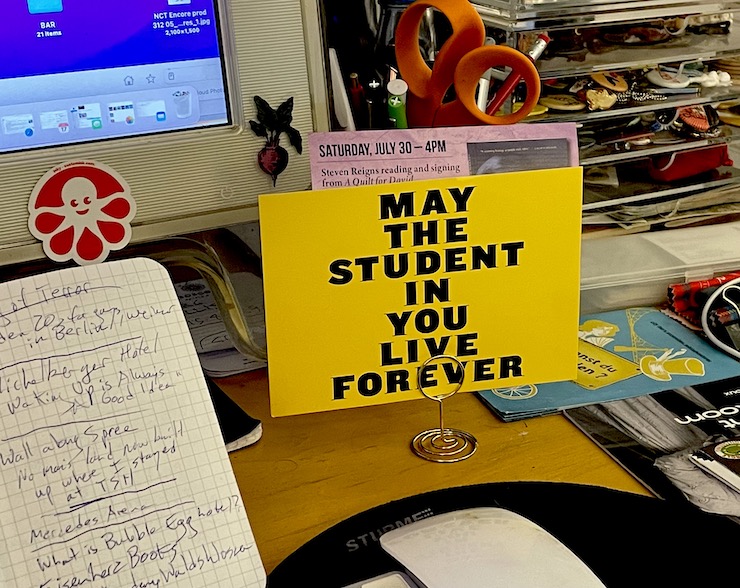
It welcomed me to my hotel room in Berlin when I checked in after a long day of flying from San Francisco with a brief, blurry layover in Munich. The sentiment was immediately appealing, but as jet-lag would have it, the card also brought a not-quite-coherent jumble of questions to mind:
How much can a visitor experience in a fleeting week’s visit to a city? Am I the right guy for Berlin’s notorious gay nightlife? Isn’t that yellow color reminiscent of the fabric stars Jews were force to wear by the NAZIs during WWII? Was someone getting a haircut in the the lobby just now?
Startled awake by my room phone about two hours later, I answered with a disoriented “Huhoh?” “This is the front desk, there’s a Mister Holger here to see you.” “Fuh! Shih! Be right down!” I slapped cold water on my face, sprinted to the elevator and pushed L, for my trip’s first lessons.
It turned out that, yes, someone had been getting a haircut in the lobby. Buzzes and trims are among the surprising array of services offered by my homebase for the next few days: The Student Hotel. (That postcard, in addition to inspiring me, was a successfully sticky bit of brand marketing).
One of the first in a new concept chain now operating in a dozen European cities, the 475-room Student, Berlin, offers modestly priced tourist accomodations as well as housing for international enrollees in semester abroad programs at local universities.
Dedicated rooms for travelers are separated from student quarters (which include communal kitchens); but sprawling indoor and outdoor lounges, quiet work/study rooms, free shared bicycles, a generously sized gym and lobby pop-up shops are open to all.
There’s no tatty-round-the-edges hostel vibe here, but the whole place does buzz with youthful energy—and students willing to share tips on their own recent urban discoveries. I met friendly kids from France, Spain, Holland and Brazil, all happy to engage in conversation with a middle-aged American stranger to whatever extent their English skills would allow. A stay at the Student fits Berlin’s gestalt. This is a city that is always reinventing itself, perpetually in the throes of its latest youth.
East meets west
In the lobby, I met Holger Linde-Margalit, a native Berliner who now leads food- and LGBT-themed tours of his city. Now 53, was himself a college student during of one of the city’s most dramatic reinventions. As we stepped out into a balmy spring evening, he recalled joyful chaos in the streets on November 9, 1989 when, after 28 years as an island of democracy surrounded by Soviet-controlled East Germany, the Berlin Wall came down.
“It was wonderful. Crazy.” Holger recalled of the clamor on both sides of the quick-dissolving border. “Everyone was out celebrating.”
The Student’s location in contemporary Berlin’s central district (called Mitte) would have fallen within East Berlin, less than a mile from the walled border. Just to its south, the Kreuzberg kiez (an affectionate term Berliners for their neighborhoods) has long been home to some of the city’s best people watching.
“This was the end of the world in the 80s and 90s,” explained Holger as we walked through the borough, “It was awesome.” Situated at the easternmost edge of West Berlin, the borough was a poor area with a large Turkish immigrant population. But artists, gays and iconoclasts of all sorts began moving here for the cheap rents and sense of frontier freedom, building community and, eventually, establishing businesses. But even today, compared to what’s thought of as gentrification in most cities, the bar and gallery-lined Oranienstrasse and its environs still have a jostling, multicultural, rough and tumble feel.
They also still have plenty of Turkish food. Among the stops on my Fork & Walk tour with Holger was Doyum, an otherwise modest looking joint considerably spruced up by walls of intricately patterned blue tile. The cumin-scented smoke wafting from the grill had my mouth watering and the kusbasi pide, an oval flatbread covered in fragrant, oil-slick lamb strip and ezme, a vibrant spread of fine chopped tomatoes, onions, walnuts, and red pepper purée didn’t disappoint. Ayran, a traditional drink made with tangy natural yogurt, water and salt was a surprisingly comforting accompaniment.
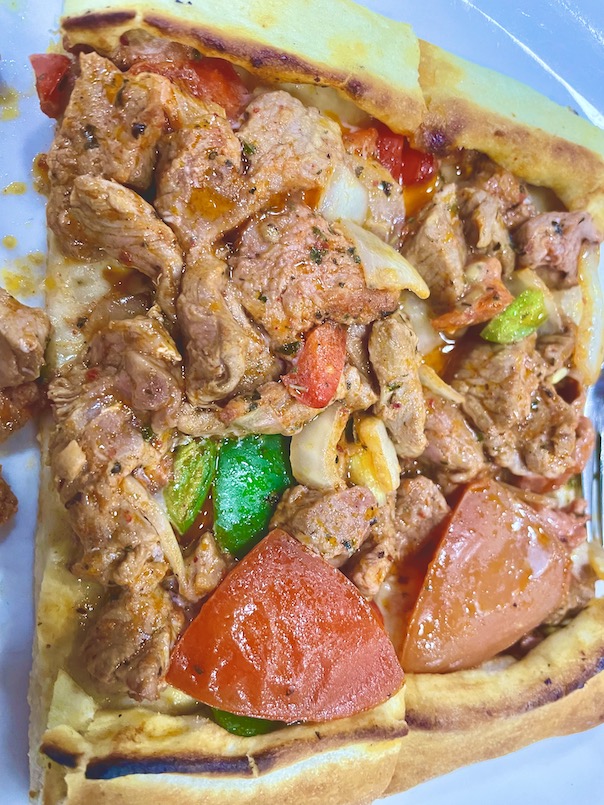
Given the city’s proliferation of kebab stands, it could reasonably be argued that Turkish is Berlin’s signature cuisine. But Ach nein!, an army of Omas would surely protest, so to keep the grannies at bay, Holger took me to a sleek little bistro called Klinke, where you can actually have a meal of traditionally heavy German cuisine and still have the energy to go dancing afterwards. Call it Teutonic tapas: delicate, elevated three-bite versions of classics like cheese spaetzle topped with crispy onions, dumplings and blood sausage, golden potato croquettes or a few wee meatballs. Wash it down with a nice glass of Gewurtztraminer and you’re good to go, pants still buttoned.
For a post-prandial promenade, stroll east for about 20 minutes to the Spree River. Just across the bridge is the East Side Gallery, an almost mile-long section of the Berlin Wall left standing and transformed into a fantastic gallery of street art. It features over 100 murals by artists from 21 countries, the most famous of which is “My God, Help Me to Survive This Deadly Love,”
which satirically depicts a juicy kiss between Leonid Brezhnev and Erich Honecker, former leaders of the U.S.S.R. and East Germany (Brezhnev died in 1982; Honecker fled to Chile after the fall of the Wall but was later brought back to Germany to stand trial for human rights abuses).
Elephants in the room
As I woke up on my first full day in in the city, that bright yellow postcard caught my eye once again, and I felt its words goading me into scholarly seriousness: Of all the places I’ve had the good fortune to visit in this world, Berlin felt the most freighted with educational obligation. As a gay Jewish man, there was a part of me that, frankly, felt strange about vacationing in the capital of a country where members of my extended genetic and chosen families had been systematically persecuted in relatively recent times. Was this a place I could let myself enjoy, or did it demand sober revisiting of history lessons?
Both, perhaps, but there was no way to ignore the latter. Berlin, to its credit, while constantly evolving, is not in the business of forgetting. There are markers and memorials to victims of the Holocaust throughout the city and they’re well worth visiting over the course of a stay.
The best known is a field of almost 3,000 irregularly arranged concrete slabs of varying heights, bluntly named Memorial for the Murdered Jews of Europe. While the design, by architect Peter Eisenman has been criticized by some as too cool and abstract, I found that walking within its vast gray disorder generated a compelling mixture of reflection and unease. The site’s enormous size and disruptive effect in the center of the city force regular reckoning and wrestling with the history it represents.
I leavened my mood by returning to the Kreuzberg neighborhood to visit a more life-affirming counterpart to this memorial, the Jewish Museum Berlin. One of the most visited museums in all of Germany—in part because of its stunning titanium-clad lightning strike design by American architect Daniel Liebeskind—it pays tribute to the cultural, intellectual and spiritual contribution of Jews in Germany both before and beyond the Holocaust.
Just a few blocks away from the Jewish Holocaust memorial, on the grounds of 520-acre Tiergarten Park, known as the city’s “green lung”, is the Memorial to Homosexuals Persecuted Under Nazism. Echoing the larger memorial, it consists of a huge, irregular black concrete block. But a small window reveals an interior chamber where a brief film of same sex kissing plays in a loop, ingeniously defying death in its transmission of unending passion.
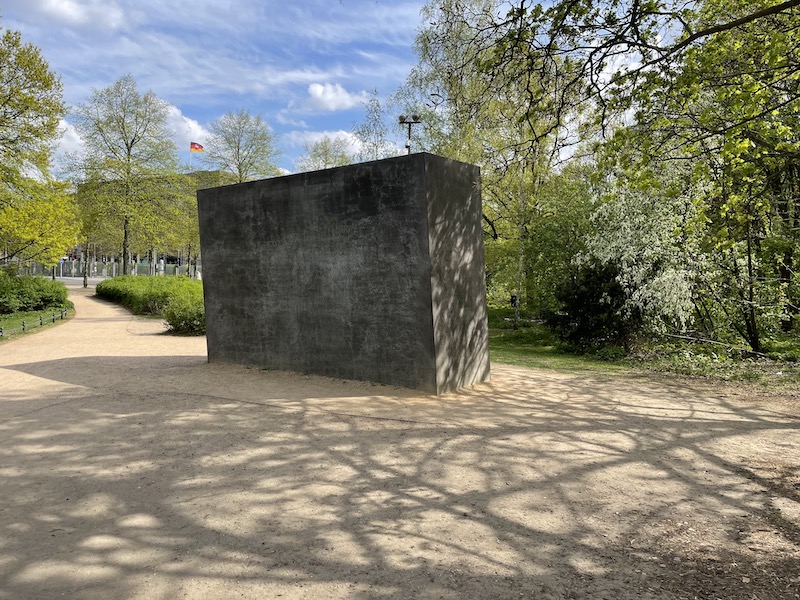
Nearby in the park, a circular reflecting pool memorializes the Sinti and Roma (pejoratively referred to as ‘gypsy’) victims of the Holocaust, a single flower at its center is replaced each day.
Two Holocaust memorials resonated more strongly for me than those paying tribute to specific populations of victims: At the Bebelplatz, a public square where thousands of confiscated books deemed representative of “decadence and moral decay” (among them works by Einstein, Marx, Freud and Thomas Mann) were burned at an enormous Nazi rally in 1933 is Israeli artist Micha Ullman’s permanent installation, The Sunken Library.
As you walk across what appears to be an empty cobblestone courtyard, you arrive at a transparent glass plate; look down and you’ll see a spare white underground room lined with empty bookshelves—enough space for the 20,000 volumes that were incinerated. Visit after dark, when soft light rises from the hollow, persistent illumination instead of flames lit by ignorance and intolerance.
Most moving of all was the Stolpersteine, or stumbling stones, a unique memorial scattered through Berlin and beyond. Since 1992, nearly 80,000 of these 4”x 4” metal blocks have been embedded in sidewalks just outside the last homes where people lived before they fled or were relocated due to Nazi persecution.
Their upper surfaces, each engraved with the name of a single person, lie flush with the pavement. Relatively inconspicuous individually, the stones’ aggregate power is immense. As a pedestrian unexpectedly ‘stumbles’ across them from time to time, they finds themself momentarily engaged with an ever-present past. The stolpersteine helped me keep my balance through a week of walking in Berlin: “Never forget,” they nudged. “But as long as you carry the lessons of memory, its ok to keep moving along.”
Curious cuisine
As anyone who’s ever sat shiva can tell you, mourning can work up a healthy appetite. So one evening, after thirty minutes’ meditative journaling at the gay memorial, I treated myself to a high-end meal with a queer Berlin spin. Located in the edgy, chic Neukolln neighborhood, the restaurant Coda has two Michelin-stars and a set menu of seven courses, every one of them a dessert.
In the hands of culinary impresario René Frank, ‘dessert’ is a non-binary term, without fixed ties to the savory or the sweet; it signifies only that each dish is made using techniques he’s developed across kitchens in Spain, France, Japan and Switzerland, winning four global “Pastry Chef of the Year” awards.
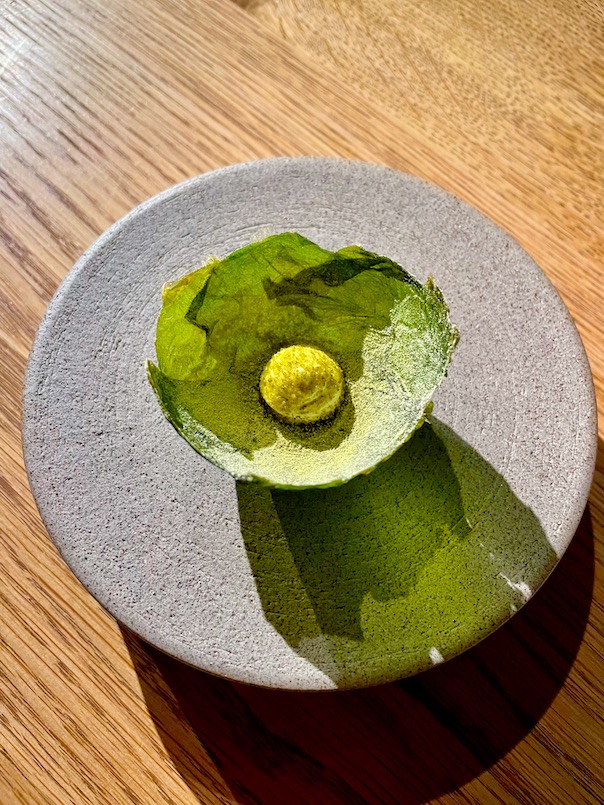
Using no refined sugar whatsoever, Frank and the small team in his hushed, laboratory-like open kitchen coax muted natural sweetness out of a wide range of largely vegetarian ingredients, then combine them in visually elegant and texturally exciting combinations. Candied lettuce with pickles? Beetroot gummy bears? A tiny waffle with raclette cheese and powdered kimchi? Yes, yes and yes. It’s as if Willy Wonka bonked the Jolly Green Giant.
Each plate is accompanied by an equally inventive miniature cocktail, mixed from an impressive array of bottles, decanters and eyedroppers. What pairs well with balsamic eggplant confit seasoned with licorice salt? Well, a potion of muscatel wine, oolong tea and cardamom eau de vie, of course!
I ate at the four seat kitchen counter, so I could chat with the chef and Adam, a charming barman, who pointed me The Truffle Pig around the corner for after dinner drinks. To get to this speakeasy-style hideaway, ring the bell on the back wall of the Kautz and Kiebitz pub. From fanciful options like the Dolce & Banana to a stiff mix of bourbon, bitters, amaro and blood orange called Goodfellas, the mixology here is top notch and well-balanced.
Other Berlin bars notable for a little something extra are Fragrances, in the Ritz-Carlton, where you choose your favorite scent from a selection of classic perfumes and are served a cocktail that complements it; and Bellboy, where incredibly theatrical presentations include drinks presented in giant seashells, ice shaped like flowers, and an outré libation called “A Lesson in Fisting” that’s served in a clenched ceramic glove (While the drink packs a punch, it doesn’t seem quite right to call it a cocktail).
Bellboy is the junior iteration of an original location based in Tel Aviv; one of a burgeoning number of businesses being established in Berlin by Jewish entrepreneurs from around the world- including Australian native Dov Selby, the owner of Fork & Walk food tours -who are relocating here to embrace the city’s creative vibe and helping it move beyond past infamy.
Before heading off to tipple in other parts of town, don’t leaving Coda’s Neukolln neighborhood without a stop at Silver Future, a kitschy dive bar which draws a truly diverse queer crowd of hims, hers and thems and frequently hosts drag shows that are sloppily avant garde.
Where the gays are
Today, Berlin is home to one of the world’s strongest, most visible and most accepted queer communities. If your historical memory reaches back no further than WWII, this may seem perplexing. But long before that dark chapter, the city had established its reputation as a haven for gay men and lesbians.
Alongside a bend in the Spree just north of the Tiergarten is yet another memorial. This one, though, feels more celebratory than solemn. Honoring “The First Homosexual Emancipation Movement” this arrangement of six brightly painted 13-foot-tall sculpted calla lilies with petals in the colors of the traditional rainbow flag was inspired by the pioneering initiatives of queer Berlin lawyer Karl Ulrichs. Calla lilies were chosen because each flower has visual and reproductive characteristics evocative of both male and female human sexuality. (Who knew my Berlin studies would include a brief course in botany?!)
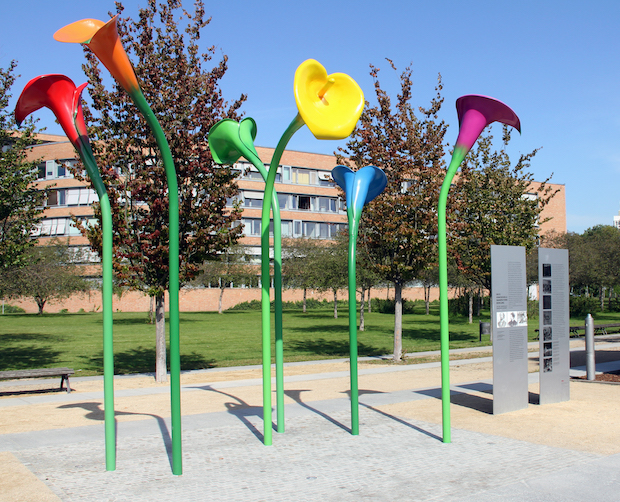
Ullrich began to promote the notion of social acceptance of gays and lesbians and to protest longstanding laws against homosexual acts early as 1864—a year before the end of the U.S. Civil war! His efforts were built upon by Dr. Magnus Hirschfeld- both gay and Jewish -who in 1897 organized the Scientific-Humanitarian Committee, widely considered the world’s first same-sex and transgender rights organization. Promoting the notion of “Justice through Science” the group’s public campaigns and political lobbying continued until the rise of the Nazis in the early 1930s, when Hirschfeld’s scholarly Institute of Sexology was sacked and he fled the country. In 1935, Hirschfeld died an exile, in France.
But the work of Ullrich, Hirschfeld and lesbian counterparts including Johanna Elberskirchen and Toni Schwabe was not in vain. By the 1920s, there were nearly 100 bars, night clubs and cafés catering to queer clientele who made their way to Berlin from around the world. While hardly embraced by mainstream society, they found the cosmopolitan city amenable to building their own sense of identity and continuing to assert their right to broader acceptance, planting seeds for the movement’s future.
After WWII and a period of dormancy and disarray that continued through the building of the Wall in 1961 and beyond, the torch of queer community and activism was picked up once again on the western side of divided Berlin, centered in the Schoneberg kiez, which today remains the city’s most distinctly gay neighborhood, east or west.
Here, you’ll find storied sites including the former Eldorado an internationally famed queer dance hall and trans gathering spot in the 1920s, immortalized Christopher Isherwood’s novel Goodbye to Berlin (still marked, but now a supermarket) and the still-thriving art deco style Metropol club, which helped launch the careers of Depeche Mode, Morrissey and the Human League in the 1980s.

Over five dozen queer-focused businesses dot the charming, tree-lined streets of this pink bourgeois area, including Prinznecht, a sprawling pub with indoor and outdoor seating particularly popular for happy hour; the Romeo and Romeo Café; Eisenherz, one of the world’s best remaining literary gay book shops; an outpost of the international Axel gay hotel chain; leather gear superstore Boxer and bespoke fetish wear tailor shop Butcherei Lindinger.
There are also plenty of small cocktail and cruise bars, although the difference between the two significantly less clear cut that in the U.S.: Virtually every gay bar in extremely open-minded Berlin has a sectioned off darkroom or basement area where casual sexual activity is welcome; establishments that specifically identify themselves as cruising spots are more single-mindedly so and frequently require guests to check their clothing or adhere to specific kink dress codes throughout the entire venue.
Make no mistake, while sometimes called a “gay village”, Schoneberg is by no means a gay ghetto, with a diverse population and some of the city’s most appealing shopping and dining options for locals and visitors of any stripe. Chief among these is KaDaWe, Berlin’s department store mecca, founded in 1907. Akin to- but significantly hipper than -Harrod’s in London, its array of luxury fashion includes deep cuts from German menswear brands including Jil Sander’s “German Prada”; club styles by GMBH; and streetwear from Berlin-based Esther Perbandt, selected as “the world’s next great global brand” on Tim Gunn’s “Making the Cut”.
Don’t miss KaDeWe’s gob smacking 6th floor food hall, where you can not only find all manner of fancy goodies to take home as gifts- handmade candies, gorgeously packaged preserves, an extraordinary range of teas and coffees -but treat yourself to an afternoon’s grazing on 1300 varieties of cheese, a sparkling raw bar selection and cakes so beautifully decorated they could attend the Met Gala. (About a ten minute’s walk from here, in the neighboring Charlottenburg kiez, you’ll find another fabulous spread of edibles at Rogacki, a 94-year-old delicatessen most famed for its smoked fish).
For a romantic evening in Schoneberg, treat your schnuki to dinner at celebrated chef Tim Raue’s handsome Brasserie Colette. Impeccable service and delicious cuisine- tender gnocchi with spring peas and morsels of peach napped in creamy blue cheese, a superb bouillabaisse, pistachio crème brulée -comes at a very fair price.
And if you’re hungry for knockout breakfast or brunch in this gayborhood, don’t miss gay-owned Fruhstuck 3000, a cheeky, creative daytime only joint serving cheddar waffles with chili-bacon caramel and banana bread topped with peanut-chocolate ganache.
Where the other gays are
While Schoneberg has long been the best known, symbolically central gay district in the city, it no longer represents the cutting edge of queer Berlin. In fact, when I met with 23-year-old Christopher Schneider, an earnest young staff member at the Berlin headquarters of LSDV, Germany’s leading LGBTQ advocacy organization, he explained that his own Gen Z peers tend
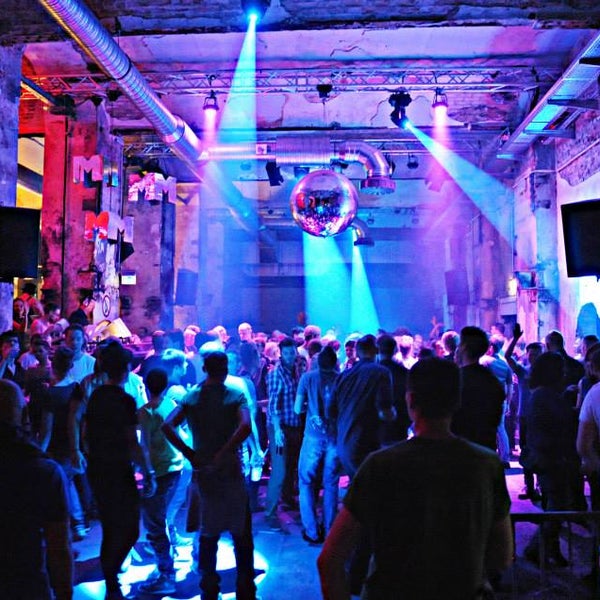
to spend their leisure time in other quarters of the city, particularly the more easterly Neukolln, Kreuzberg, Friederichshain and Prenzlauer Berg, considering Schoneberg to represent “old school” points of view.
“Its mostly popular with people 35 and over,” he articulated. “Many friends my age say its too ‘gay’; that its not a place where people appreciate the ideas of queer and non-binary identity as much.”
In a discussion that would strike many members of the American gay community as familiar, Schneider says that while socially engaged LGBTQ Germans of his generation are sometimes too strident in their focus on proper pronoun use, he also feels that middle-aged and older members of the community have grown overly comfortable and complacent in their expectations and definitions.
“There is a real generational gap,” Schneider acknowledged. “I’ve learned so much about our history from some of my older colleagues, but there is also some lack of tolerance around newer thinking. I really hope that both sides learn to listen to each other more.”
Asked where one could find the city’s most gender- and generationally-inclusive queer nightlife,
Schneider recommended SchwuZ in Neukolln. I found his tip to be spot-on when I visited the huge hybrid nightclub and cultural center on a late Friday night when close to a thousand partiers from their twenties through their sixties cheerfully shared multiple dancefloors, one of which was dedicated to new mixes of old Madonna.
Now in its fourth and largest location, SchwuZ has served as a progressive meeting place since 1977, and hosts not only late night dance parties but readings, lectures, cabaret shows, films and concerts. Long a booster of queer artists and activists, in 2021, it established a non-profit charitable foundation to provide formal means of financial support.
Also beyond Schoneberg, Berlin boasts an extraordinary number of sex-positive queer and all-inclusive venues, parties and periodically scheduled one-night takeovers of more mainstream spaces. Among those worth checking out are Chantal’s House of Shame extravaganzas held every Thursday night at the Suicide Circus club and the every night camp of Monster Ronson’s Ichiban Karaoke, both in Friedericshain; the open-to-all Turkish and Arabic queer party Gayhane held every fourth Saturday; and the shoulder-to-shoulder cramped kitsch bars Mobel Olffe (a former furniture store with lots of remnant merchandise to lounge on) and Rose’s, in Kreuzberg.
It can be hard to stay on top of Berlin’s robust and ribald queer scene, with new events and venues constantly popping up. Fortunately, given its status as a major economic generator and international draw, the city’s tourism bureau proudly provides regularly updated information and links to even some of the more outrageous on its own website, VisitBerlin.de.
You can also feel entirely comfortable asking for specific advice on queer nightlife and cultural activities at any of the hotels in the Pink Pillow Collection, a network of specially trained and certified accommodations that are particularly hospitable to LGBTQ guests and committed to keeping up with Berlin’s distinctive offerings for gay visitors. You’ll find Pink Pillow members located in virtually any kiez you’d like to lay your head in, including accommodations ranging from hostels to B&Bs to five-star brands.
I luxuriated through my last two days in the city at one of the latter, the spectacularly situated SO/Berlin Das Stue. In a former Dutch embassy building tucked in a tranquil diplomatic enclave on the edge of the Tiergarten, the hotel is a short walk from the Schwules Museum of gay history. An inviting sunlit garden has its own private entrance to the Berlin zoo. And if giant pandas aren’t a sufficiently posh amenity, there’s always the elegant indoor pool and sauna, a library piled with Taschen art books, and the hotel’s own art collection which pays whimsical to the neighboring menagerie. The staff even wear custom-designed Victor & Rolf uniforms with clever animal motifs (And remember, this being a Pink Pillow establishment, you can feel free to inquire about spots to meet bears, otters and other local wildlife).
The daddy of all clubs
Berlin is packed with polymorphously perverse petting zoos, perhaps the most notorious being Berghain, a gargantuan former electric power station converted into an electronic music club. Setting several city blocks athump every weekend from Friday at midnight through early Monday afternoon, Berghain is a DJ- and drug-fueled free-for-all, with booming, high-ceilinged dance floors interspersed with labyrinthine dark rooms. Admission fees are extremely modest, but be prepared for hours long queues even in early dawn hours. And waiting in line by no means assures getting in once you reach the entrance.
Sven Marquard, severe in his gray-streaked beard and 24-7 sunglasses, leads the world’s most inscrutable crew of bouncers; they will assess your wardrobe, interrogate you aspirations and look you deep in the eyes to scan your soul before deciding whether you’re admitted (about one in three hopefuls are turned away, and if you come with a group don’t count on all making it in). Its supposedly easier to win passage if you dress simply (and in black), make an effort to politely answer questions in German, and—yes!—are queer. Still, there’s never a guarantee.
There is one major lubehole—uh, loophole!—for gay men, but it requires its own sort of courage. To the left of Berghain’s main entrance is a concrete loading dock that leads to a males-only basement level (with no inside access to the other parts of the club) known as Lab.Oratory. Lines are shorter, but there’s a limited two-hour period each night during which guests are allowed to arrive and dress/undress codes vary from night to night. Tamping down my sense of intimidation to adopt a “When in Berlin…” attitude and, of course, be of generous service to Passport readers, I took the plunge for a learning experience.
The night’s theme was among the Lab’s least specific (nudity, underwear and leather gear were all deemed acceptable outfits). I deposited most of my clothes at a check-in desk and, in just a jockstrap, socks and sneakers, entered a large dimly lit bar room humid with beer and ballsweat. Hundreds of nearly naked men- skinny, heavy, smooth, hairy, muscled and dad-bodded -drank, flirted and danced to techno between forays into side halls and chambers where all manner of mansex went down with libertine boldness.
While I’d convinced myself I was ready for anything before arriving, I quickly realized that I was only ready to see anything. And frankly, even from just a people-watching perspective, a little Lab.Oratory went a long way. The student in me may indeed live forever, but Phys Ed was never my thing.
Lessons learned
It turns out that for this visiting scholar, a week’s visit was the perfect length for my Berlin 101. In some ways, I feel like I barely scratched this amazing city’s surface, but from another perspective, I realize that the city burrowed deep into my mind, generating new questions and curiousities to explore on a return trip to Berlin.
This provocative metropolis is a testament to the possibility of moving forward and learning from loss. Its a potent reminder that identity- and opinions -need not remain fixed; that open mindedness and open heartedness make good traveling companions.
Did I have fun Berlin? Absolutely. But much more. Because the real joy in travel is not in “taking a vacation” but in continuing one’s lifelong education.
Berlin Resources
INFORMATION
The most valuable central resource for both general and LGBTQ-specific travel planning, featuring annotated links to individual lodgings, restaurants and attractions is Visit Berlin. www.visitberlin.de
LODGING
The Pink Pillow Collection. A network of nearly 60 certified queer-friendly lodgings in Berlin https://bit.ly/pinkpillowbe, which includes:
SO/Berlin Da Stue. Drakestrasse 1. Five-star luxury in a tranquil leafy park setting. Tel: 49 303117220. www.so-berlin-das-stue.com
The Student Hotel. Alexanderstrasse 40. Tel: 49 30 31198339. Modestly priced, attractive and modern with a youthful, international clientele. www.thestudenthotel.com
TOURS
BigBus Berlin. Two extensive hop on, hop off routes to all major tourist attraction. www.bigbustours.com. [RA: No phone]
Fork & Walk Tours. Tel: 49 173 9297290. Private and group culinary walking tours with expert guides, including vegan options. https://forkandwalktoursberlin.com/tours
Queer Tours Berlin. Tel:49 173 9100442. Historical and cultural tours led by queer guides who provide LGBTQ-specific context. www.queerberlin.com
DINING
Brasserie Colette. Passauer Strasse 5. Tel: 49 30 21992174. Elegant French-accented bistro cuisine near popular gay bars and shopping. www.brasseriecolette.de
Clarchens Ballhaus. Auguststrasse 24. Tel: 49 30 555785440. Pretzels, wienerschitzel, pickels and meatballs, for lunch and supper like your German grandma made. www.claerchensball.haus
Coda Dessert Dining. Friedelstrasse 47. One-of-a-kind fixed price pairings of avant-garde drinks and not-so-sweet desserts. Tel: 49 3091496396. www.coda-berlin.com
Doyum. Admiralstrasse 36. Tel: 49 30 616656127 Phenomenal Turkish grill in the hip Kreuzberg neighborhood. www.doyum-restaurant.de
Fruhstuck 3000. Bülowstrasse 101Tel: 49 304 3666659. Creative queer-owned breakfast and lunchery in Schoneberg gay village. www.fruestueck3000.com
Klinke. Dresdenner Strasse 119. Tel: 49 3023521568. Ingenious transformation of traditional German cuisine into elevated small plates. www.klinkeberlin.com
Rogacki. Wilmersdorfer Strasse 145. Tel: 49 30 3438250 Legendary delicatessen with smoked fish that will hook you. www.rogacki.de
MEMORIALS & MUSEUMS
Humboldt Forum. Schlossplatz, Museuminsel. Tel: 49 30 992118989. www.humboldtforum.com
Opened in 2021 and finally drawing deserved crowds as the pandemic recedes, the Humboldt Forum on Museum Island is a spectacular new cultural complex located at a landmark location with a tumultuous 800 year history as a monastery, royal palace and political headquarters, remnants of each of which have been incorporated in its latest reconstruction. In addition to tours and exhibitions exploring the controversial evolution of the site itself, the forum also showcases major national collections of Asian, African, Antipodal and American ethnological artifacts reflecting Germany’s colonial past along with provocative presentations on controversies associated with that history. An array of special temporary exhibitions on subjects from modern art to the sciences populate additional halls and galleries. A magnificent rooftop observation deck over looks the Spree River and surrounding cityscape.
East Side Gallery. Muhlenstrasse 70. Street art showcase on standing remnants of the Berlin Wall. Tel: 49 30 213085-123
Gropius Bau. Niederkirchnerstrasse 7. Tel: 49 30 254860 Must-see modern art museum and performance space. www.gropiusbau.de
Jewish, Homosexual and Sinti-Roma Memorials. All in eastern Tiergarten Park area. www.stiftung-denkmal.de/en/memorials
Jewish Museum Berlin. Lindenstrasse 9. Tel: 49 30 25993300. One of the most popular museums in all of Germany; architect Daniel Liebeskind designed the stunning modern campus. www.jmberlin.de
Memorial to the First Homosexual Emancipation Movement. Magnus-Hirschfeld-Ufer.
Schwules Museum. Lutzostrasse 73. Tel: 49 30 69599050 World’s first museum dedicated to LGBTQ culture and history. www.schwulesmuseum.de.
Stolpersteine. An emotionally powerful collection of individual “stumbling stone” memorials found throughout Berlin and elsewhere. www.stolpersteine.eu
Sunken Library. Bebelplatz, Unter der Linden. Contemporary art installation memorializing Nazi book burning. www.visitberlin.de/bebelplatz
Topography of Terror. Niederkirchnerstrasse 8. Tel: 49 30 25450950. On the site of the one-time Third Reich secret police headquarters, exhibitions on the SS and the Nazi regime. www.topographie.de
NIGHTLIFE
Bellboy. Mohrenstrasse 30. Tel: 49 30 20077070. Theatrical Israeli-owned cocktail bar and restaurant www.bellboybar.com
Berghain. Am Wriezener Banhof. No phone. Fortified citadel of electronic music and debauchery, with notorious entry policies. www.berghain.berlin
Chantal’s House of Shame. No phone. Suicide Circus, Revaler Strasse 99. Friday nights end on Monday mornings at this weekly queer dance party and exhibition of excess. www.facebook.com/chantalshouseofshame
Fragrances. Potsdamer Platz 3. Tel: 49 30 337775403. Pricy libations are matched with exotic perfumes in this swank Ritz-Carlton hideaway. www.ritzcarlton.com/en/hotels/germany/berlin/dining/fragrances
Gayhane. SO36 Club, Oranienstrasse 190. Tel: 49 30 61401306
An exuberant monthly dance party featuring Turkish and Arab club music. www.facebook.com/gayhane
Lab.Oratory. Am Wriezener Banhof. No phone The raunchiest gay men’s gathering spot in town. Be mindful of the night’s theme lest you wander into unwanted watersports. www.lab-oratory.de
Mobel Olfe. Reichenbergerstrasse 177. Tel: 49 30 23274690. This artsy queer bar in a former furniture shop has plenty of chairs to sit in. www.moebel-olfe.de
The Truffle Pig. Reuterstrasse 47. Tel: 01 74 1916697. A craft cocktail speakeasy in the edgy Neukolln district. www.trufflepigberlin.de
Prinznecht. Fuggerstrasse 33. Tel: 49 30 23627444
The best patio and happy hour scene in the gay village. www.prinzknecht-berlin.de
Rose’s. Orienstrasse 187. 49 30 6156570. Pink and kitschy queer oasis in the heart of Kreuzberg barhopping. www.facebook.com/profile.php?id=100067838141500
SchwuZ. Rollbergstrasse 26. Tel: 49 30 57702270. The largest most welcoming queer club in town has a cheerful demeanor that’s slightly surprising for Berlin. www.schwuz.de
Silver Future. Weserstrasse 206. 49 30 23900855. Young and punky nonbinary dive bar in Neukolln with inventive genderqueer drag shows. www.silverfuture.net
SHOPPING
Boxer. Eisenacherstrasse 11. Tel: 49 30 21917220 Sleek and friendly Barcelona-born fetish gear and undy emporium. www.facebook.com/boxerber
Butcherei Lindinger. Motzstrasse 18. Tel: 49 30 20051391. Sexy leather that’s made to measure. www.butcherei.com
Eisenherz. Motzstrasse 23. Tel: 49 30 3139936. One of the world’s last great queer literary book stores. https://prinz-eisenherz.buchkatalog.de
KaDaWe. Tauentzienstrasse 21. Tel: 49 30 21210. The Harrod’s of Berlin with high fashion and an eye-popping food hall.
